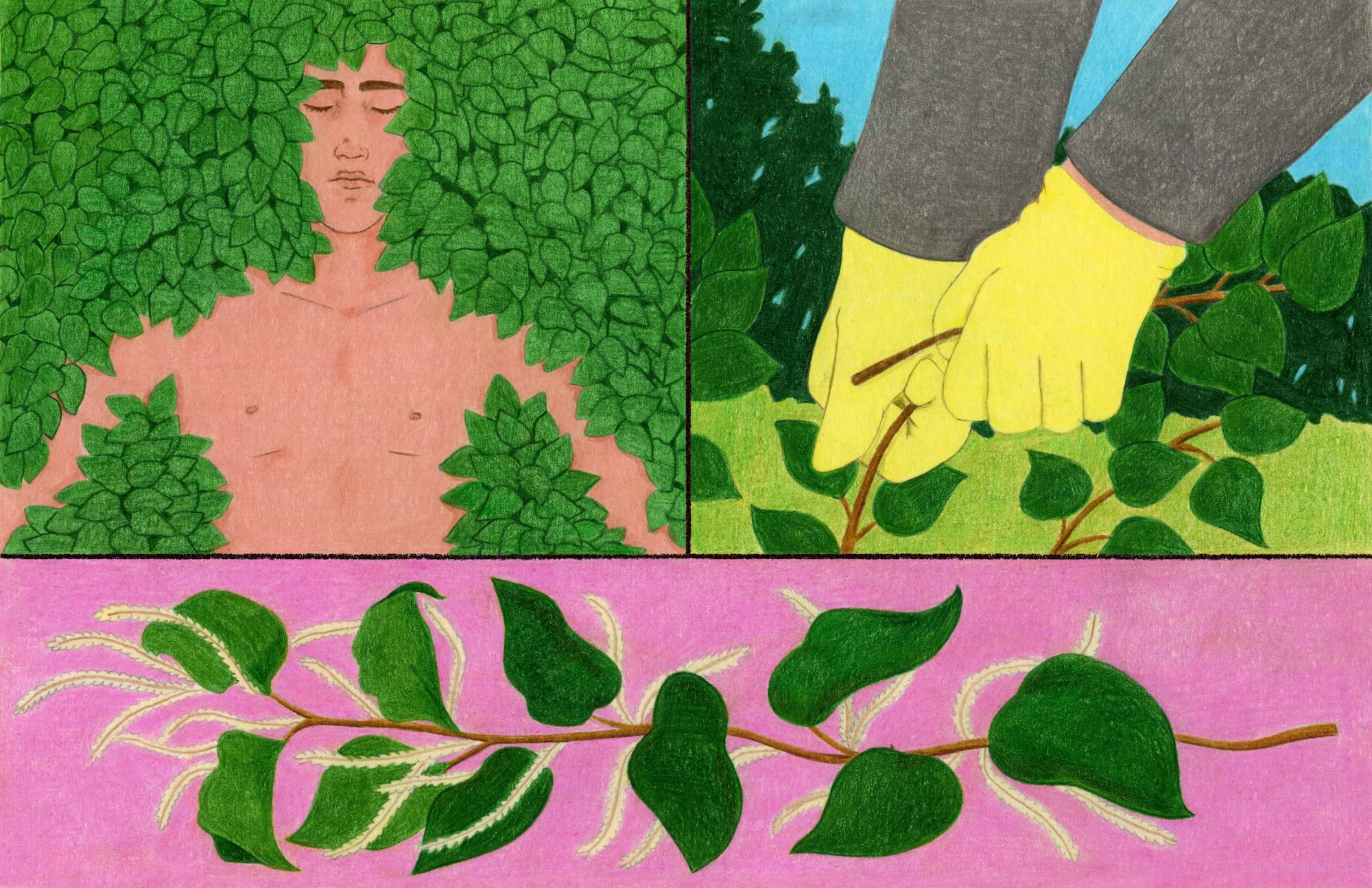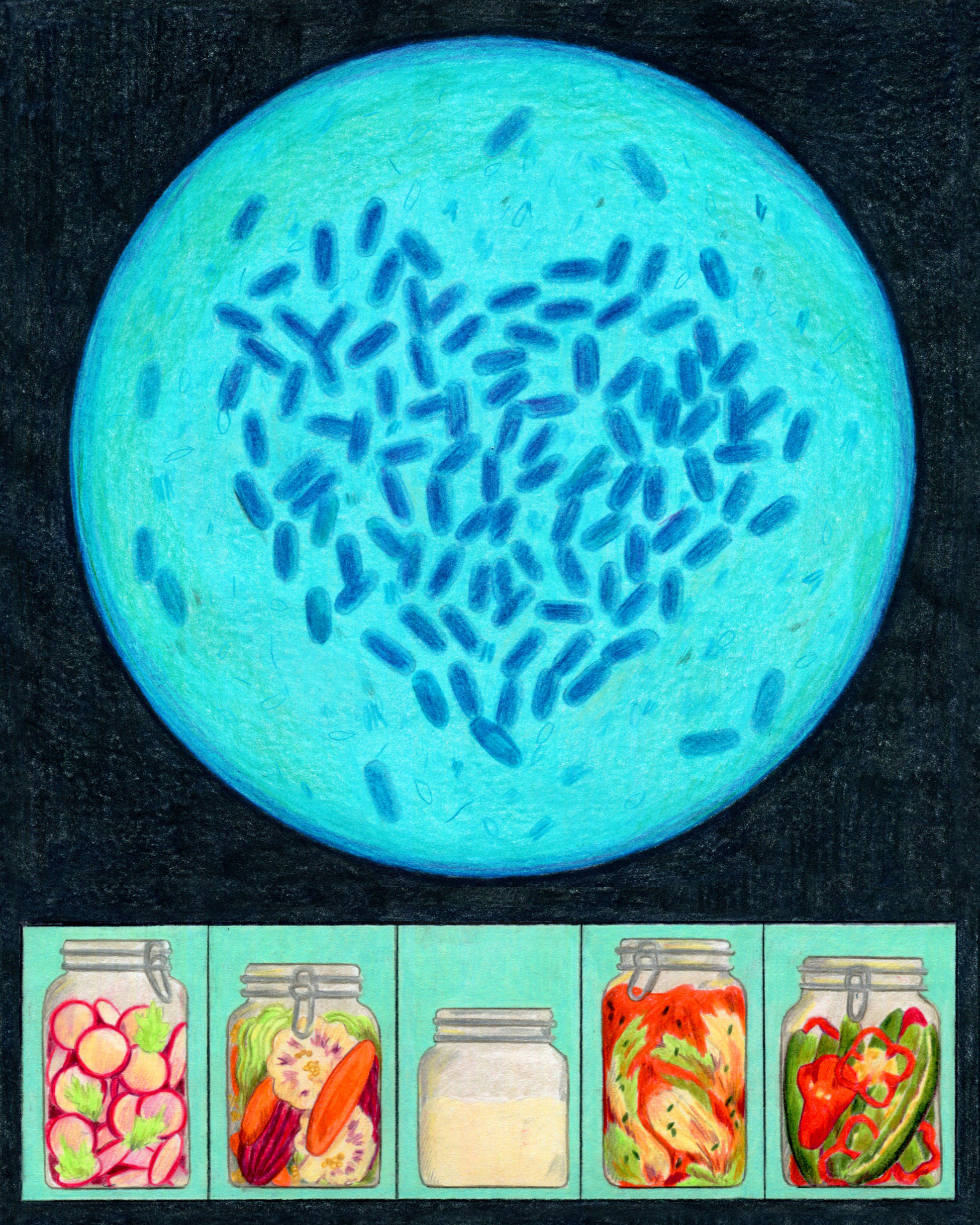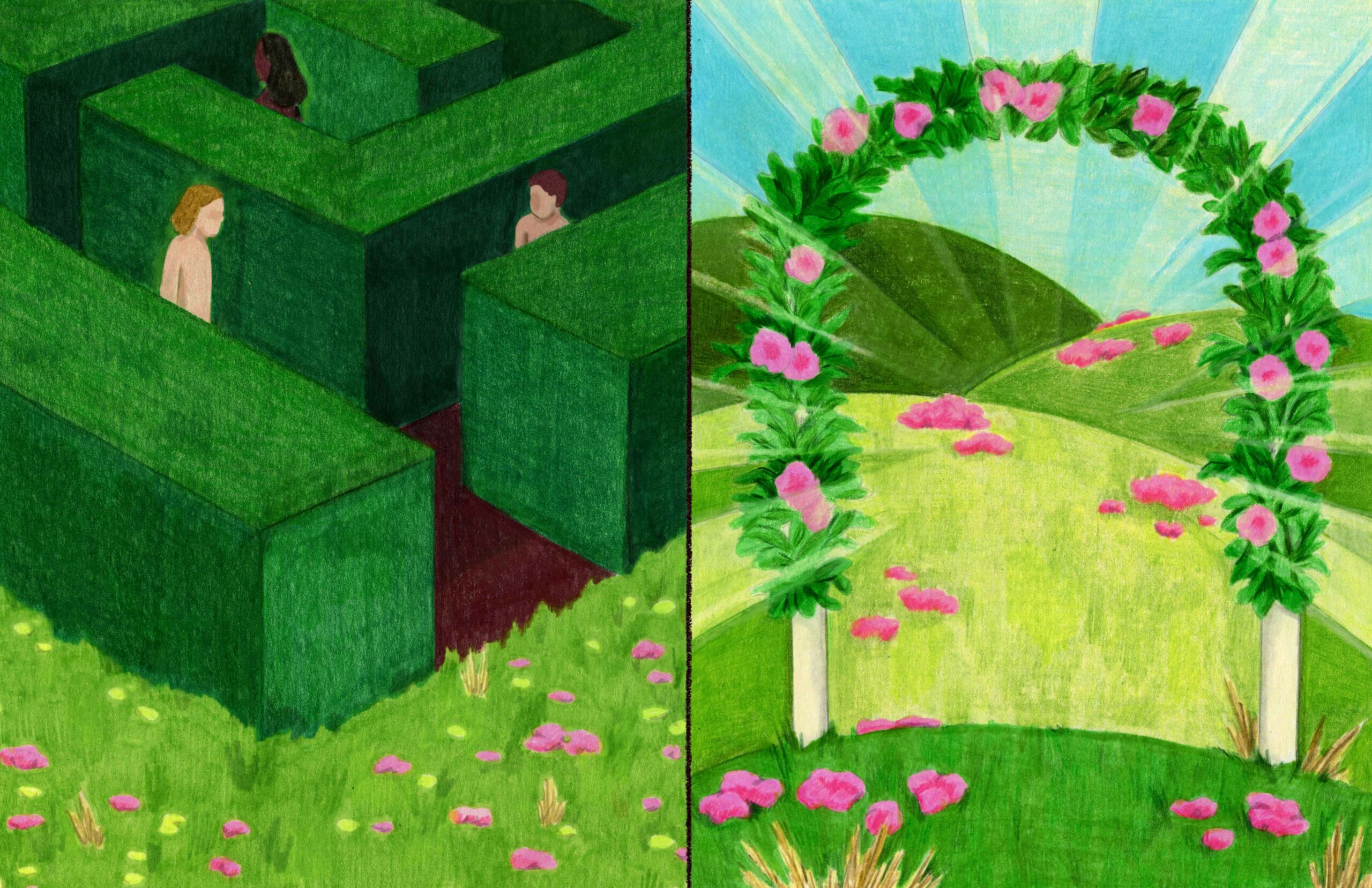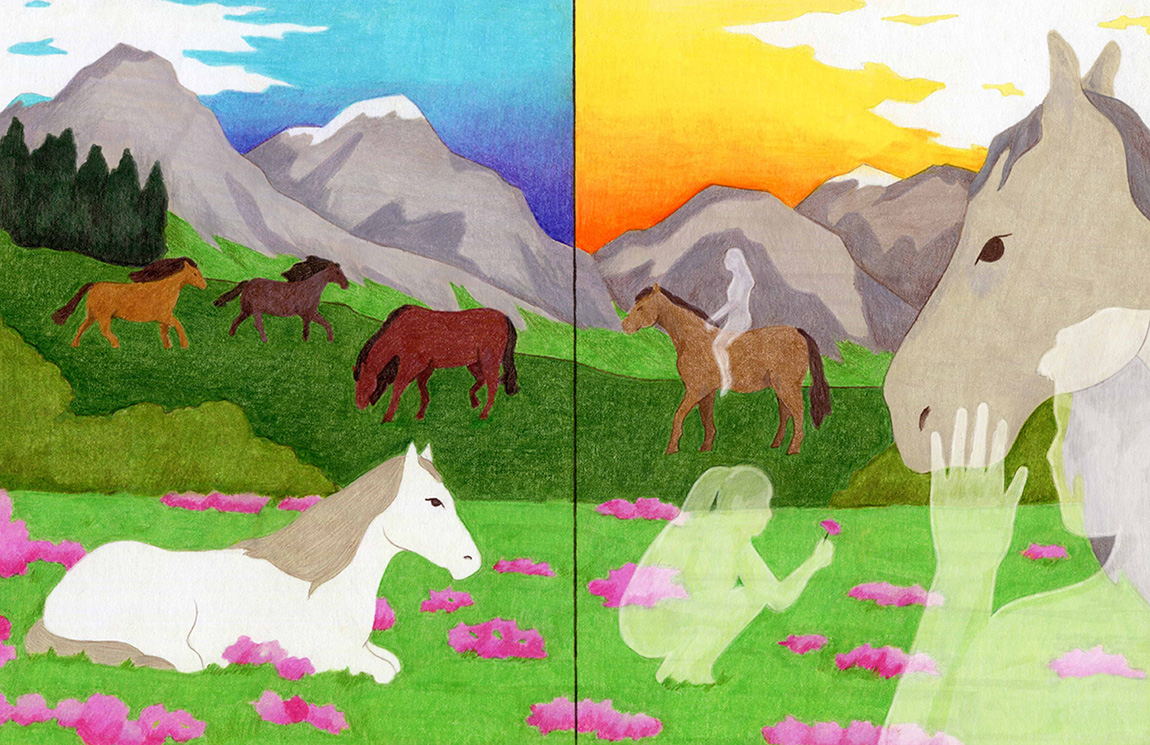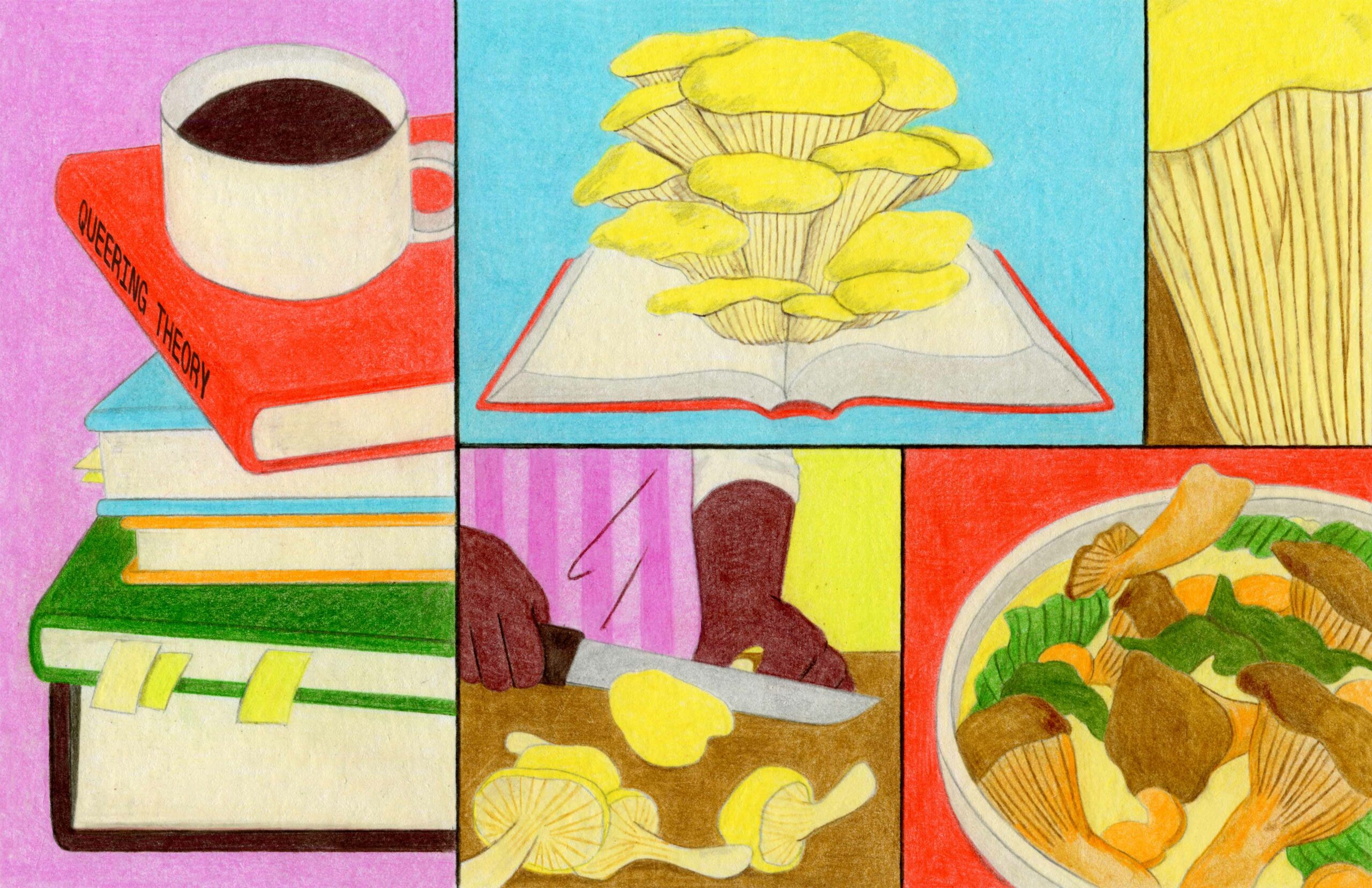Queering Theory untangles critical theory through the multifarious lens of queer theory, food, and ecology.
Creeping between the cracks and fingering fissures in façades, they creep their tendrils beneath constructed order, raising chaos and razing foundations. Mutable and thoroughly reviled; they are weeds: the antithesis of human endeavour. Insistent in their existence despite our persistence in extinguishing them, weeds are nature’s most resilient agents. They diversify our monocultures,1 and care for the nature we destroy,2 building anew from the pieces humans leave in their wake.
In this series’ previous piece, we looked past the dualism of conventional ecology, which conserves ‘natural’ spaces in unnatural states. The drive to minimise human interference, however, often comes to the detriment of those who have historically coexisted within them. The piece concluded by suggesting that it is the much-maligned, oft-overlooked ecologies that thrive in our ruin which might offer us insight into how to reunite our dualism and re-see ourselves as a part of nature, not apart from it.
In this third article in the Queering Theory series, we peek over the walls of the third space; a place of overlap where different cultural concepts can sprout and proliferate out from under a prying social gaze.3 In these liminal spaces, dualism becomes harder to define, our perceptions can break from aesthetics, and ideas can emerge, queering their way through the undergrowth.
- 1. Put anthropocentrically, weeds cause widespread devastation, reducing crop yields by up to 45% through resource competition, potentially affecting food shortages and, at their worst, famine.
- 2. Put conservationally, species capable of fastpaced growth and remediation, when introduced to an ecology unused to them, can outcompete already-established species. Should they reach an equilibrium, they might evolve to coexist, but should the existing species not have the biological wherewithal to withstand the newcomers advances, they could become endangered.
- 3. Third space theory, attributed to the professor Homi K. Bhabha, is a postcolonial suggestion of a space outside of domestic and civic engagement, where true expression can be enacted. Postcolonialism studies the legacies of colonialism from political, cultural, and economic perspectives.
However, before diving head-first into this thicket of theory, let us first pick our way through some outlying notions, and begin by asking What is a weed? A weed is a plant that should either grow in the wrong place, or lack beauty or use.4 Its definition relies on anthropocentric perceptions of right and wrong, aesthetics, and practicality. Weeds are thus a construct; strip human agency from their categorisation, and you’ll be left with a plant.
Biologically, this becomes a little convoluted. Though weeds might be a semantic construct, we put words into action when we sowed our first seed by deciding what species were right, useful or beautiful. In the aeons since, we have inadvertently bred weeds to be equipped with a unique skillset to successfully do what we most want them not to: to thrive. This is because every weed left unweeded passes on the secrets of its survival to another generation, ensuring posterity. This is a very generalist understanding, but it serves to communicate that, in selecting against weeds, we have, in fact, been rooting for them all along.
Even before we sowed our first seeds, proto-weeds already excelled in this field. Naturalist Richard Mabey writes in his eponymous Weeds (2012) that these species are nature’s reparators.5 Long before we disturbed the ground, they evolved to fill the empty spaces left by nature’s destructive arsenal of fires, floods, landslides, etc.6 His book is a treatise to see weeds anew, as the remediators and repairers of the dualistic rift we have wrought between us and nature. This echoes Fred Pierce, who I referenced in Queering Conventional Conservation, whose The New Wild (2015) champions the ecologies that thrive unbidden in our spaces.
- 4. ‘Weed’, Wordnik. (2024). The American Heritage Dictionary of the English Language, 5th Edition. Accessed 28/05/24.
- 5. In Roman mythology, Reparator—one of the helper gods of Ceres, the goddess of agriculture—was worshipped for the preparation of fallow land for crops.
- 6. 289, Mabey, R. (2012) Weeds: The story of outlaw plants. London: Profile Books.
Some see ‘weed’ as a label so fluid it transcends plants. In his 1975 Crops and Man, agronomist Jack R. Harlan wrote that “[i]f we confine the concept of weeds to species adapted to human disturbance, then man is by definition the first and primary weed under whose influence all other weeds have evolved.”7 Understood as a social category, weeds, when defined by disruption, cause chaos to the cultural order. In this piece, we’ll be focussing on the semantic over the biological; which will lead us into an exploration of their social translations.
In my introduction, I suggested weeds to be non-normative. When socially translated, this might read as contentious, so let me elaborate. As discussed, ‘norms’ are the general systems within which we function; that which sits outside of this is ‘non-normative.’ By comparing the terminology of a ‘weed’ to non-normativity, it is not a suggestion that these identities should be ‘weeded out,’ but rather a semantic reclamation against an overwhelmingly monocultured society. Weeds were, after all, thriving long before we labelled them as such. As such, within monocultures they play social and ecological diversifiers. Let me highlight that this is a metaphor with which I identify, but one size does not fit all. In fact, differences in opinion are encouraged, for they engender diversity of thought, which is the very purpose of this piece.
As we have explored, weeds are defined by human thought. Whether in the wrong place, of no beauty, or without use; should a plant not behave according to our designs, it is a weed. This is perception: ‘the way in which something is regarded, understood, or interpreted.’ Or condemned. When perception dictates what’s ‘right,’ that which isn’t, automatically becomes ‘wrong.’ These perceptions are, among other things, dictated by aesthetics; a Eurocentric classicist philosophy which dictates taste, defining what we should appreciate, and eschewing what we shouldn’t. They are, in other words, a ‘norm.’ In this, weeds are insightful, for they challenge these philosophies by their defined lack of use or beauty.
- 7. p. 88, Harlan, J. R., (1975) Crops and Man. Madison: American Society of Agronomy.
- 8. ‘Perception’. Apple Dictionary. (2024). Oxford Dictionary of English.
Despite being ostracised as ‘other,’ sitting outside the norm imbues them with the power of non-conformity, enlightening us to other ways of being.
The aesthetics by which we perceive are compounded by our understandings of tended natural spaces. 18th-century landscape architect William Kent believed landscapes should be viewed as classical paintings, arranged to maximise aesthetics—think ‘picturesque.’ His more famous successor ‘Capability’ Brown—supposedly England’s greatest gardener—furthered this. Brown’s landscaping emerged at a turning point in horticultural aesthetics, when regimented geometry slipped into organic appreciation. His work was typified by ‘natural’ stands of trees, ‘organic’ lakes, and rolling grassland; his innovation, in short, to convert a natural landscape into a ‘natural landscape.’
In Queer Ecologies (2010), Mortimer-Sandilands et al. identify how, despite Indigenous presence, the supposedly ‘pristine’—or ‘Edenic’ (my take)—landscapes encountered by European colonists in the Americas impacted contemporary European perceptions of what an unspoilt nature should look like.9 Brown’s landscaping testifies to this. At the time, much of Europe had been stripped of coverage, succumbing to human development. With little ‘wilderness’ left, once-rigid horticultural traditions and their geometric subjugation of nature could relax into an appreciation of the now-rarer, ‘natural’ landscapes being encountered across the Atlantic.
- 9. p. 12, Sandilands, C. M., & Erickson, B. (2010). Queer Ecologies. Indiana: Indiana University Press.
Though gardens might not be on the ecological vanguard they’re a valuable insight, for in their aesthetics they reveal the most widely spread social notions of nature. A garden is, after all, an idealised curation of how we want to perceive nature; a practice in controlling the uncontrolled. Visit any era, and a peek over the garden wall might enlighten us about their perceptions of the natural world. Gaze longer over this proverbial wall, and you might also see the creeping tendrils and self-seeded shoots against which the garden has always battled, for weeds define these perceptions just as much as patio plants do.
In their most virulent form, weeds become the abject, their supernatural powers filling us with the horror of the unknown. In Powers of Horror, the philosopher Julia Kristeva suggests the abject as a human reaction to the breakdown of meaning, through the loss of distinction between subject and object; self and other.10
- 10. Kristeva, J., (1982). Powers of Horror: An Essay on Abjection. New York: Columbia.
In the context of aesthetics, the abject is its’ antithesis, for it unnerves us with its unfamiliarity. Abjection is characterised by the unconventional and atypical; it is the non-norm incarnate.
One weed that embodies this definition of the abject is Japanese knotweed (Reynoutria japonica), a wondrous plant with the notional power to destabilise the very foundations of Western civilisations. A mere slice of its rhizomatic stem might spawn a forest, and its widespread damage to human infrastructure affects a notional awe-cum-horror in us in our inability to control it. When I first found knotweed I felt chilled, as if the triffid might leap up and consume me. Turns out it’s delicious in salads, yet its taste is still tart with that lingering abjection.
Here, we return to queer. I would like to reiterate: I am not labelling myself or any other queer-identifying person horrifyingly abject. That is the reserve of lost souls tangled in the far-right folds of normative thinking. Instead, I am suggesting the power these emotions have in their unfamiliarity; a power I believe to reside in both weeds and queers: the power of the unknown. Weeds are, in my mind, nature’s most relatable species. Rogue radicals; they negate the rules.
By being ‘wrong,’ weeds exist as philosopher Mary Douglas’ ‘matter out of place,’11 as that which transgresses classification, becoming imbued with the power of the uncontrolled. Earlier we defined weeds as not being right, useful, or beautiful; yet does this a definition make? Instead, weeds are oxymoronic, for they are defined by their lack of definition. When something is defined by everything it isn’t, then everything it is becomes its power. Philosopher Michel Foucault suggests that by naming something, it passes over into the discourse that receives it; i.e., naming gives control.12 This is what ‘weed’ is: a notional power grab to make us feel better about the reality that, despite millennia of trying to subdue them, they persist in resisting control.
This, then, is weeds’ disruption. Despite being ostracised as ‘other,’ sitting outside the norm imbues them with the power of non-conformity, enlightening us to other ways of being. In her 2015 The Mushroom at the End of the World, theorist Anna Tsing writes “[w]atching landscapes in formation shows humans joining other living beings in shaping worlds.These landscapes thus become “radical tools for decentering human hubris.”13 Tsing’s subtitle, On the Possibility of Life in Capitalist Ruins, resonates with the third space of weeds which we introduced at the start of this article. In this space, the defined lines of dualism become smothered in the undergrowth. This is a place of perpetual non-belonging, for it will forever be defined as ‘wrong.’ Aesthetics will never see beauty in it, just as human endeavour will never see its use. Yet this is what makes it so great, for who would want to be normal and right?
Out from the other side of this thicket of theory, the definition of ‘queer’—alighted upon in this series’ first piece—becomes important in understanding why I suggest this correlation. Queer is ‘odd,’ ‘strange,’ or ‘peculiar.’ It is never normal. Weeds, by never being ‘right,’ are similarly liberated to forever be ‘wrong.’ Both are filled with the power and potential of the unknown, which instils abject fear in the norm, while at once holding wonderful limitless potential. Importantly: my suggestions are far from binary, they in fact encourage all of the open interpretation that is queer thinking. For that is what queer is: limitless interpretation, sprouting from between the cracks and persistently resisting by existing.
- 11. p. 36, Douglas, M. (1966 [2001]). Purity and Danger: An analysis of concepts of pollution and taboo. Routledge: New York.
- 12. p. 147, Foucault, M., (2003 [1966]). The Order of Things. London: Routledge.
- 13. p. 152, Tsing, A. (2015). The Mushroom at the End of the World: On the Possibility of Life in Capitalist Ruins. Princeton University Press.
- 1. Put anthropocentrically, weeds cause widespread devastation, reducing crop yields by up to 45% through resource competition, potentially affecting food shortages and, at their worst, famine.
- 2. Put conservationally, species capable of fastpaced growth and remediation, when introduced to an ecology unused to them, can outcompete already-established species. Should they reach an equilibrium, they might evolve to coexist, but should the existing species not have the biological wherewithal to withstand the newcomers advances, they could become endangered.
- 3. Third space theory, attributed to the professor Homi K. Bhabha, is a postcolonial suggestion of a space outside of domestic and civic engagement, where true expression can be enacted. Postcolonialism studies the legacies of colonialism from political, cultural, and economic perspectives.
- 4. ‘Weed’, Wordnik. (2024). The American Heritage Dictionary of the English Language, 5th Edition. Accessed 28/05/24.
- 5. In Roman mythology, Reparator—one of the helper gods of Ceres, the goddess of agriculture—was worshipped for the preparation of fallow land for crops.
- 6. 289, Mabey, R. (2012) Weeds: The story of outlaw plants. London: Profile Books.
- 7. p. 88, Harlan, J. R., (1975) Crops and Man. Madison: American Society of Agronomy.
- 8. ‘Perception’. Apple Dictionary. (2024). Oxford Dictionary of English.
- 9. p. 12, Sandilands, C. M., & Erickson, B. (2010). Queer Ecologies. Indiana: Indiana University Press.
- 10. Kristeva, J., (1982). Powers of Horror: An Essay on Abjection. New York: Columbia.
- 11. p. 36, Douglas, M. (1966 [2001]). Purity and Danger: An analysis of concepts of pollution and taboo. Routledge: New York.
- 12. p. 147, Foucault, M., (2003 [1966]). The Order of Things. London: Routledge.
- 13. p. 152, Tsing, A. (2015). The Mushroom at the End of the World: On the Possibility of Life in Capitalist Ruins. Princeton University Press.
